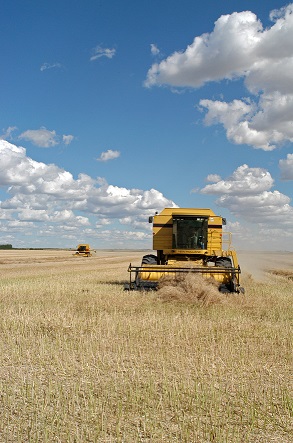Released on August 9, 2018
Producers in the province have one per cent of the crop combined and two per cent swathed or ready to straight-cut, according to Saskatchewan Agriculture’s weekly Crop Report. The five-year average for this time of year is one per cent combined. Reported yields so far range from average to well-below average.
Fifty-five per cent of the fall rye, 15 per cent of the winter wheat, eight per cent of the field peas and seven per cent of the lentils are now in the bin. One per cent of the canola has been swathed.
Harvest is most advanced in the south, where three per cent of the crop is combined. Most producers in the central and northern regions are expecting to be in the field within the next few weeks.
There was scattered rainfall in parts of the province this week, with some storms bringing hail. While the rain was welcomed in some areas, it may be too late to benefit the south, where crops are rapidly drying down. Most crops remain in fair condition, although later-seeded crops need rain to help heads and pods fill.
Topsoil moisture conditions have improved slightly with the recent rainfall. Provincial topsoil moisture conditions on cropland are currently rated as 42 per cent adequate, 40 per cent short and 18 per cent very short. Hay land and pasture topsoil moisture is rated as 32 per cent adequate, 41 per cent short and 27 per cent very short.
Hay yields are below average overall. Estimated average dryland hay yields for the province are: 1.1 tons per acre for alfalfa and alfalfa/bromegrass; 0.9 ton per acre for other tame hay; 1.0 ton per acre for wild hay and 1.6 tons per acre for greenfeed. Estimated average irrigated hay yields are: 2.8 tons per acre for alfalfa; 2.7 tons per acre for alfalfa/bromegrass; 2.2 tons per acre for other tame hay; 2.0 tons per acre for wild hay and 3.3 tons per acre for greenfeed.
The majority of crop damage this past week is attributed to lack of moisture, strong wind and high temperatures. Some areas, including Cabri and Leader, received hail that caused severe damage to crops. Producers are busy harvesting, hauling bales and desiccating crops.
A complete, printable version of the Crop Report is available online at http://publications.gov.sk.ca/redirect.cfm?p=90932&i=107829.
Follow the 2018 Crop Report on Twitter at @SKAgriculture.
-30-
For more information, contact:
Allie Noble
Agriculture
Moose Jaw
Phone: 306-694-3575
Email: allie.noble@gov.sk.ca

